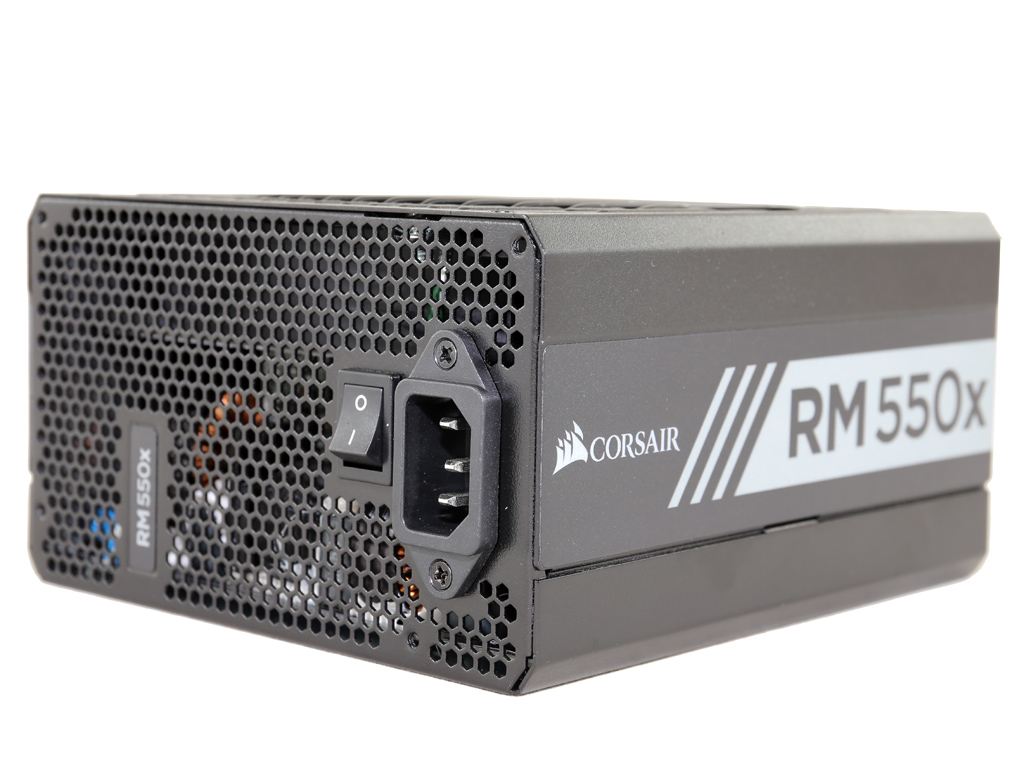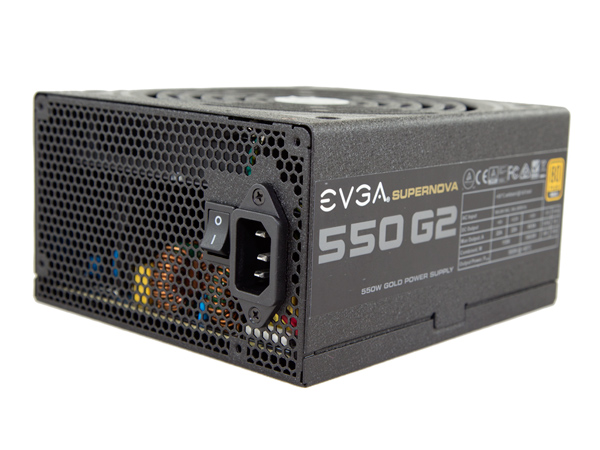Corsair RM550x Power Supply Review
The lowest-capacity unit Corsair's RMx line outputs up to 550W and is 80 PLUS Gold-certified. It features fully modular cabling, offers great performance and is nearly silent throughout its operating range, too.
Why you can trust Tom's Hardware
Load Regulation, Hold-Up Time And Inrush Current
To learn more about our PSU tests and methodology, please check out How We Test Power Supply Units.
Primary Rails And 5VSB Load Regulation
Load Regulation testing is detailed here.
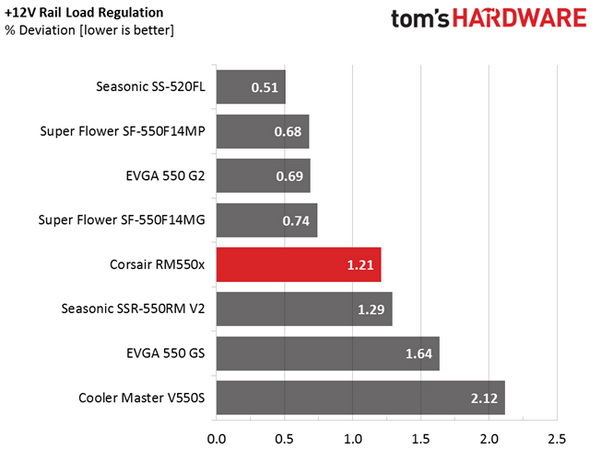
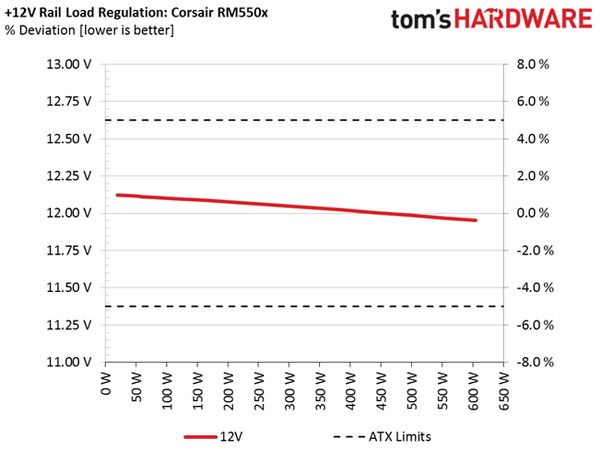
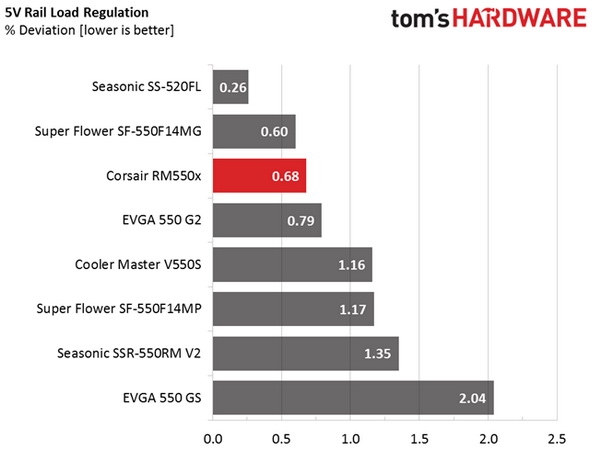
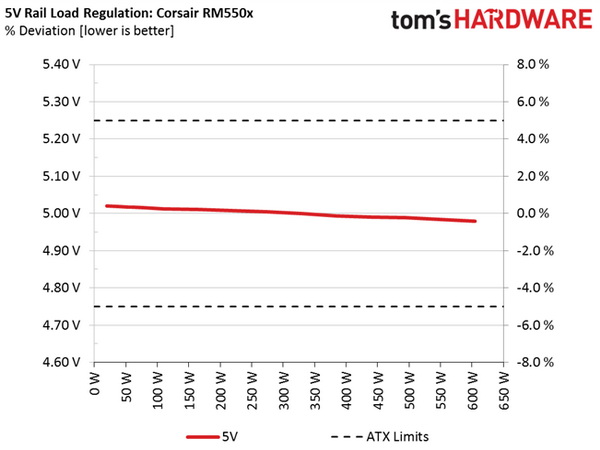
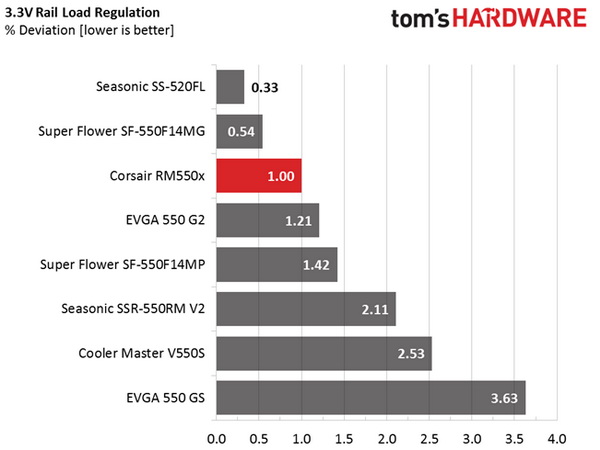
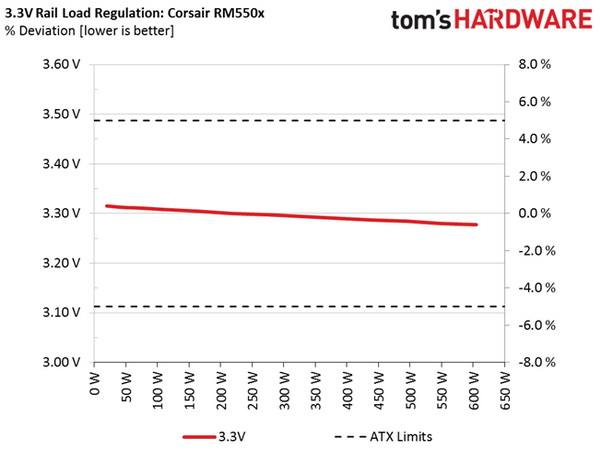
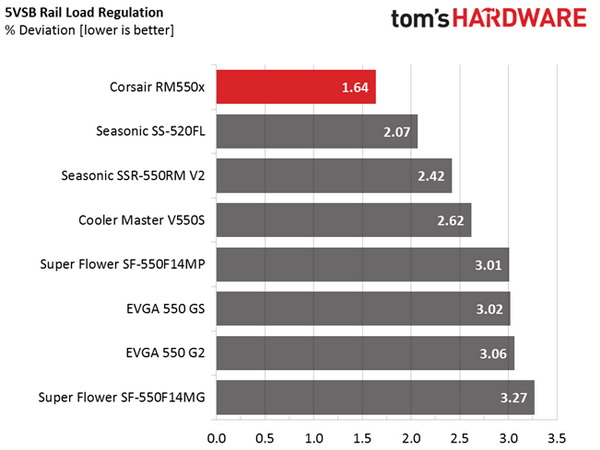
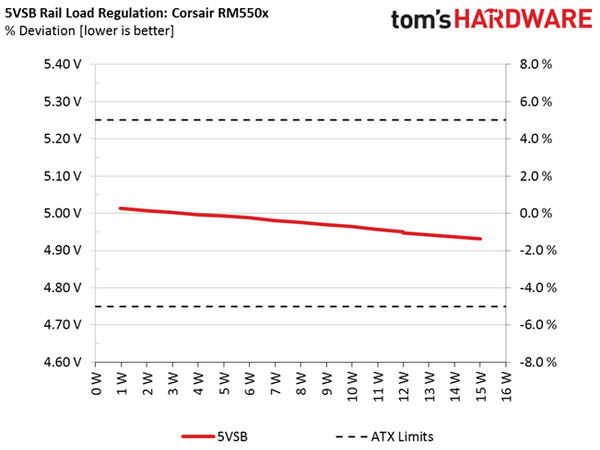
Hold-Up Time
Our hold-up time tests are described in detail here.
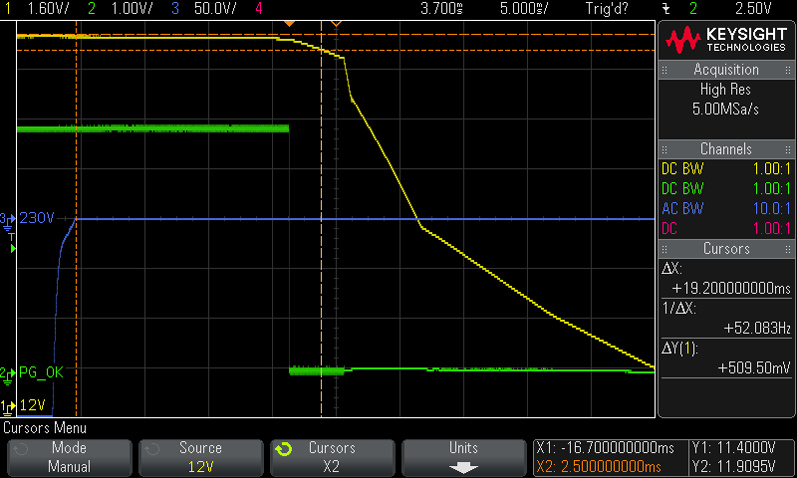
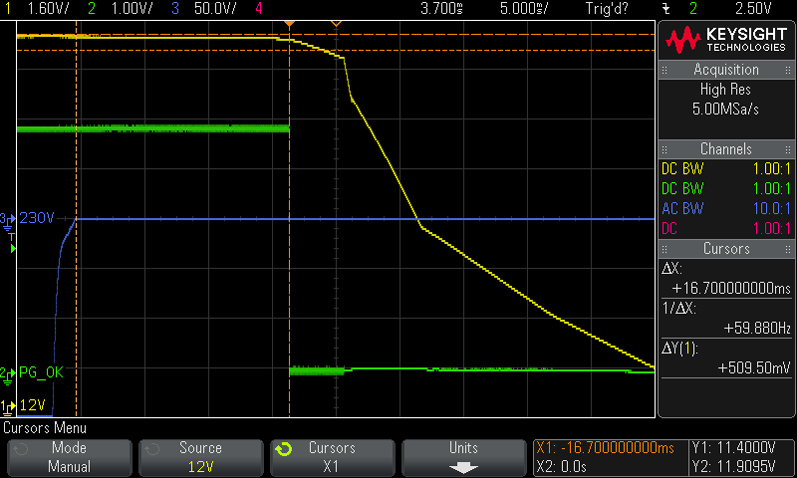
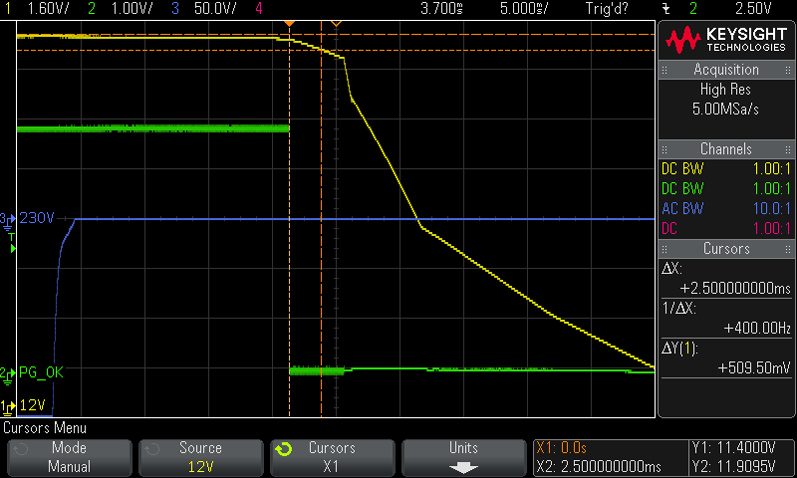
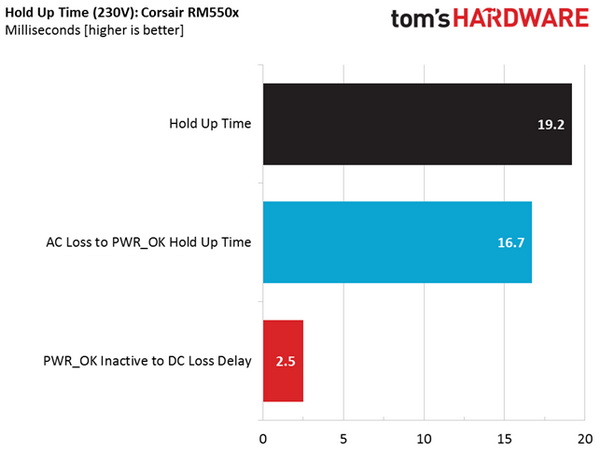
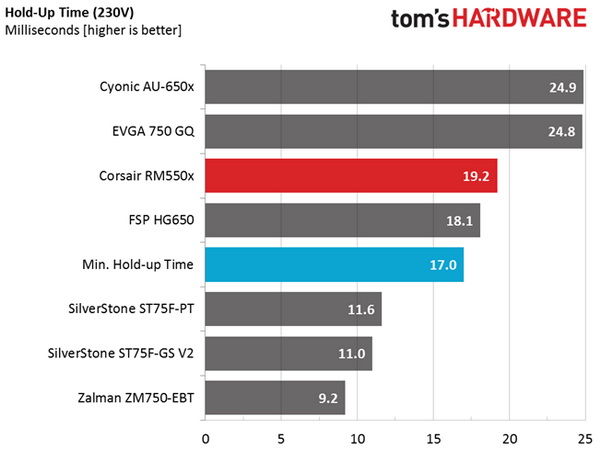
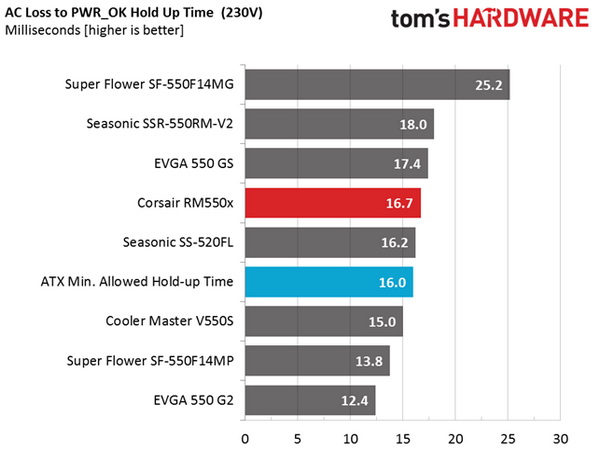
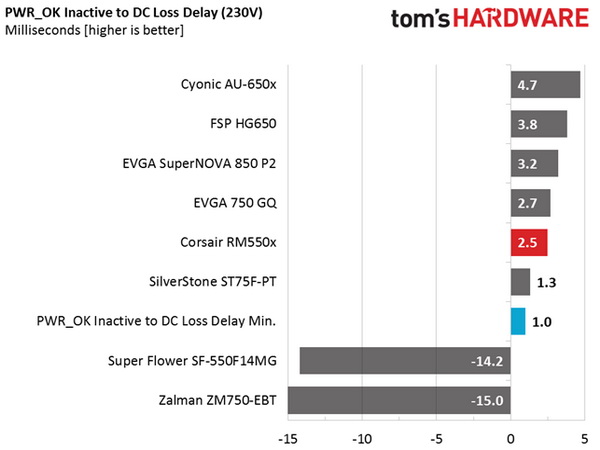
Our hold-up time measurement easily passes 17ms. Further, the power-good signal is longer than the ATX specification's 16ms minimum recommendation. This unit's single bulk cap is obviously up to the task, and it doesn't hold Corsair's RM550x back in these crucial tests.
Inrush Current
For details on our inrush current testing, please click here.
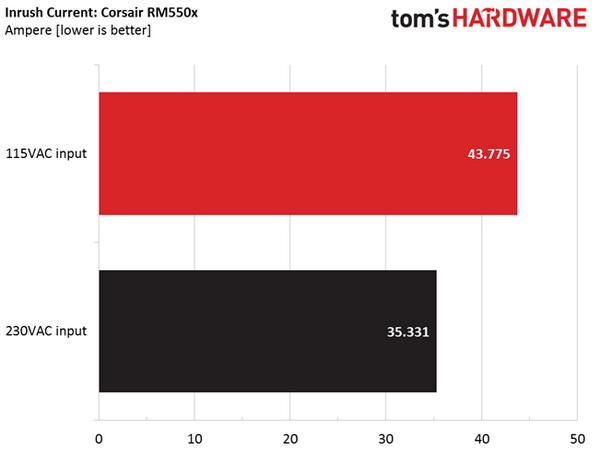
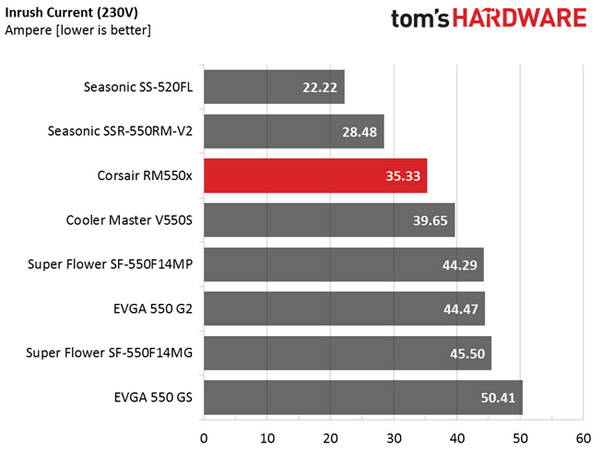
In most cases, the inrush current is pretty low. We had to repeat the corresponding test multiple times to get the readings depicted on our graphs. Although the thermistor used for inrush current protection is small, it does a good job without using a bypass electromagnetic relay.
Load Regulation And Efficiency Measurements
The first set of tests explores voltage rail stability and efficiency. The applied load equals (approximately) 10 to 110 percent of the supply's maximum in increments of 10 percentage points.
Get Tom's Hardware's best news and in-depth reviews, straight to your inbox.
We conducted two additional tests. During the first, we stressed the two minor rails (5V and 3.3V) with a high load, while the load at +12V was only 0.10A. This test reveals whether a PSU is Haswell-ready or not. In the second test, we determined the maximum load the +12V rail could handle with minimal load on the minor rails.
| Test # | 12V | 5V | 3.3V | 5VSB | DC/AC (Watts) | Efficiency | Fan Speed (RPM) | Noise (dB[A]) | Temps (In/Out) | PF/AC Volts |
|---|---|---|---|---|---|---|---|---|---|---|
| 1 | 2.739A | 1.994A | 1.990A | 1.001A | 54.77 | 83.99% | 0 | 0 | 48.04 °C | 0.944 |
| 12.114V | 5.017V | 3.312V | 4.993V | 65.21 | 39.55 °C | 115.1V | ||||
| 2 | 6.522A | 2.990A | 2.990A | 1.200A | 109.78 | 88.58% | 0 | 0 | 48.85 °C | 0.978 |
| 12.100V | 5.013V | 3.308V | 4.988V | 123.94 | 40.18 °C | 115.1V | ||||
| 3 | 10.658A | 3.497A | 3.507A | 1.403A | 164.90 | 90.01% | 0 | 0 | 50.33 °C | 0.987 |
| 12.085V | 5.010V | 3.305V | 4.981V | 183.20 | 41.40 °C | 115.1V | ||||
| 4 | 14.798A | 3.994A | 3.997A | 1.605A | 219.80 | 90.56% | 0 | 0 | 51.70 °C | 0.993 |
| 12.071V | 5.008V | 3.300V | 4.975V | 242.71 | 42.45 °C | 115.1V | ||||
| 5 | 18.607A | 4.988A | 5.001A | 1.810A | 274.77 | 90.56% | 0 | 0 | 52.98 °C | 0.994 |
| 12.056V | 5.004V | 3.298V | 4.969V | 303.41 | 43.73 °C | 115.1V | ||||
| 6 | 22.423A | 6.001A | 6.010A | 2.011A | 329.75 | 90.14% | 580 | 20.8 | 43.38 °C | 0.995 |
| 12.040V | 4.999V | 3.294V | 4.964V | 365.81 | 51.16 °C | 115.1V | ||||
| 7 | 26.259A | 7.008A | 7.019A | 2.215A | 384.78 | 89.66% | 580 | 20.8 | 44.25 °C | 0.995 |
| 12.023V | 4.994V | 3.290V | 4.956V | 429.15 | 52.36 °C | 115.1V | ||||
| 8 | 30.089A | 8.016A | 8.032A | 2.422A | 439.64 | 89.15% | 580 | 20.8 | 45.05 °C | 0.996 |
| 12.006V | 4.990V | 3.287V | 4.950V | 493.15 | 53.75 °C | 115.1V | ||||
| 9 | 34.382A | 8.520A | 8.555A | 2.422A | 494.75 | 88.65% | 635 | 23.1 | 46.70 °C | 0.996 |
| 11.988V | 4.988V | 3.284V | 4.948V | 558.09 | 55.85 °C | 115.1V | ||||
| 10 | 38.425A | 9.036A | 9.054A | 3.041A | 549.68 | 88.00% | 815 | 27.6 | 47.27 °C | 0.996 |
| 11.970V | 4.984V | 3.280V | 4.931V | 624.62 | 56.78 °C | 115.1V | ||||
| 11 | 43.079A | 9.042A | 9.063A | 3.041A | 604.60 | 87.39% | 975 | 32.3 | 47.89 °C | 0.996 |
| 11.952V | 4.980V | 3.277V | 4.928V | 691.85 | 57.80 °C | 115.1V | ||||
| CL1 | 0.102A | 16.023A | 16.005A | 0.004A | 134.06 | 82.80% | 580 | 20.8 | 47.72 °C | 0.985 |
| 12.088V | 4.998V | 3.294V | 5.052V | 161.90 | 55.62 °C | 115.1V | ||||
| CL2 | 45.782A | 1.003A | 1.003A | 1.002A | 561.12 | 88.64% | 840 | 28.2 | 48.30 °C | 0.996 |
| 11.966V | 4.993V | 3.290V | 4.971V | 633.05 | 58.27 °C | 115.1V |
Load regulation at +12V isn't super tight, but it's pretty good on the other rails. On top of that, the RM550x has one of the steadiest 5VSB rails we've ever measured in a PSU around this capacity point. As you can see in the table, this PSU satisfies the 80 PLUS Gold requirements with flying colors, despite our test environment's very high ambient temperatures. This is definitely an efficient unit that will help you save some money on electricity over time.
The fan doesn't spin up to the 50% load test, and its speed is low once the control circuit engages it. Our equipment only registered more than 30 dB(A) once, and that was during the overload test with an ~48 °C ambient. To call the RM550x quiet is underselling it.
Current page: Load Regulation, Hold-Up Time And Inrush Current
Prev Page A Look Inside And Component Analysis Next Page Efficiency, Temperature And Noise
Aris Mpitziopoulos is a contributing editor at Tom's Hardware, covering PSUs.
